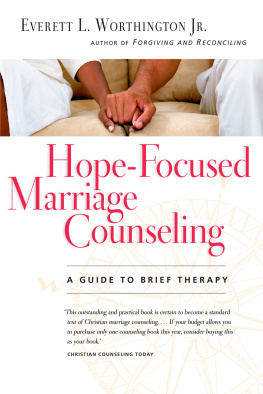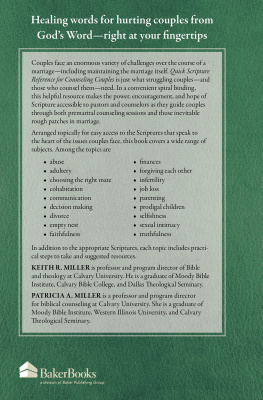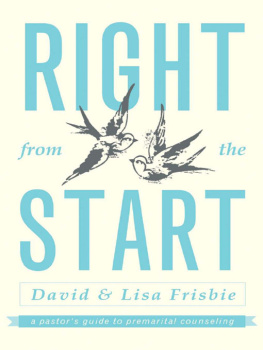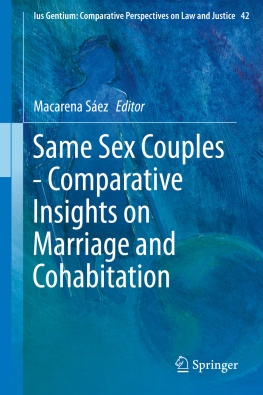FREDERICK HERTZ
COUNSELING UNMARRIED COUPLES
SECOND EDITION
A GUIDE TO
EFFECTIVE LEGAL REPRESENTATION

Cover design by Kelly Book/ABA Publishing.
The materials contained herein represent the opinions of the authors and/or the editors, and should not be construed to be the views or opinions of the law firms or companies with whom such persons are in partnership with, associated with, or employed by, nor of the American Bar Association or the Section of Family Law unless adopted pursuant to the bylaws of the Association.
Nothing contained in this book is to be considered as the rendering of legal advice for specific cases, and readers are responsible for obtaining such advice from their own legal counsel. This book is intended for educational and informational purposes only.
2014 American Bar Association. All rights reserved.
No part of this publication may be reproduced, stored in a retrieval system, or transmitted in any form or by any means, electronic, mechanical, photocopying, recording, or otherwise, without the prior written permission of the publisher. For permission contact the ABA Copyrights & Contracts Department, .
Library of Congress Cataloging-in-Publication Data
Hertz, Frederick, author.
Counseling unmarried couples: a guide to effective legal representation / Frederick Hertz. -- Second edition
pages cm
Includes bibliographical references and index.
e-ISBN: 978-1-62722-534-2
1. Unmarried couples--Legal status, laws, etc.--United States. I. Title.
KF538.H47 2014
346.7301'6--dc23
2014008461
Discounts are available for books ordered in bulk. Special consideration is given to state bars, CLE programs, and other bar-related organizations. Inquire at Book Publishing, ABA Publishing, American Bar Association, 321 N. Clark Street, Chicago, Illinois 60654-7598.
www.ShopABA.org
Contents
FOREWORD
In 1971 I joined my former Legal Aid colleague Ed Sherman in writing and publishing self-help law books under the name Nolo Press. Operating from the kitchen table of a brown shingle house in what can best be described as a hippie enclave in Berkeley, Ed and I handled divorces, bankruptcies, and consumer cases to pay the bills. Fortunately, Nolos prospects improved when sales of Eds How to Do Your Own Divorce in California took off after the president of the Sacramento County Bar Association called a press conference to warn the citizens of California against using this dangerous book.
The success of the divorce book convinced me that there was a ripe market for self-help law materials. So, along with Toni Ihara and others, I immediately got to work on writing and publishing books on tenants rights, bill payers rights, how to change your name, and other consumer topics.
By late 1973 Nolo began getting calls asking if we had any materials to help unmarried couples deal with property concerns. Typically, a worried couple was concerned about buying a house or had questions about rights and responsibilities where one partner was working to put the other through graduate school. And then there were the unmarried partners who planned to have a baby without first taking a walk down the aisle but didnt want their child to be labeled illegitimate. Knowing almost nothing about the law that applied to these situations (or the lack thereof), I helped couples draft co-ownership agreements similar to those that any business partners would create.
Word spread and more couples called. One was a young mother (Ill call her Lynn) who had just gotten a divorce. Lynn had bought a tumbledown Victorian in Berkeley; and, providentially, before the city got around to condemning the building, Lynn met and fell in love with Mike, an itinerant Australian carpenter. Soon Mike decided to move in, apply for U.S. citizenship, and fix up Lynns house. All was good for a few weeks until Mike asked Lynn, Who owns what here? Or, more to the point, what happens if I spend a year or two rehabbing your house, and then we separate?
Since neither Mike nor Lynn had a clue how to answer these questions, the work stopped and the relationship faced a crisis. My job was to help with the legal part, accomplished after much talk by drafting an ownership agreement linked to a logbook, where Mike would record his out-of-pocket costs for materials and his labor at an agreed-upon hourly rate. Since Lynn had recently bought the house and its value was known, it was easy to draft a co-ownership agreement that provided for Mikes ownership share to gradually grow based on the value of his contributions until he and Lynn were fifty-fifty owners.
But it wasnt just couples calling Nolo that convinced me that a book for unmarried couples was needed. Northern California in the early 1970s exemplified the near-tectonic shift in American social attitudes toward marriage, with the result that hundreds of thousands of couples nationally were choosing to cohabit rather than visit the altar. So in late 1973, I asked Carmen Massey, a former Legal Aid colleague and friend, to coauthor a legal guide for unmarried couples. Our first step was to research state law as it applied to the legal rights of unmarried couples. What we learned was sobering: Most state courts had ruled that contracts between unmarried partners were unenforceable. Since living together itself was in violation of state criminal law against cohabitation, most courts reasoned that any contracts formed between unmarried partners must also be illegal. At this point, I remember Carmen asking, Do we really want to do a book full of agreements courts may not enforce because they view the people making them to be living in sin?
It was a great question, and the best reply I could come up with was this: Just in the Bay Area alone, tens of thousands of unmarried couples are living together. And its happening all over the country. The counter-culture is changing the social reality, and courts will have to recognize it. Carmen asked, You mean we should do a book about where we think the law is going to be in a few years, not where it is now? Im still not so sure its such a great idea to show people how to write what may turn out to be bogus contracts. I replied, We will be doing much more than that, I hope. After all, isnt the point of written agreements to allow people of good faith to remember what they said during happy times and thus have a framework to avoid going to court if they break up unhappily? Carmen agreed, Sure. So Im okay with going ahead as long as we include full disclosure that some courts may not enforce agreements between unmarried partners. But, hey, if we are going out on a thin legal limb, lets also include agreements for gay and lesbian couples. I concurred, Good point. If we are going to write an illegal law book, no sense in holding back.
And so Carmen and I made an outline, assigned chapters, and began to write. As lawyers and recent law students, we were used to the routine and sometimes boring task of trying to dovetail yesterdays legal rule with todays fact situation. But here we realized that we were doing the opposite: creating legal structures to help deal with a fast-emerging social issue. We became so excited and energized that we completed Sex, Living Together, and the Law in record time. It was published by Nolo in 1974 and sold well, especially in bookstores in college towns.
But then in 1976, two events overtook our success. First, the California Supreme Court decided Marvin v. Marvin , a case brought by the movie actor Lee Marvins former live-in partner of six years, Michelle Triola, in an attempt to enforce what she claimed was a promise of long-term support in case of a breakup. In a huge legal sea change that ratified the approach Carmen and I had taken, the court ruled that, like anyone else, unmarried partners could form contracts as long as they were not based on meretricious (illegal) sexual services. The secondand for me more devastatingevent was that Carmen Massey died. Carmen had been a fine lawyer, a caring person, and a great friend; and I was too devastated to face working on our book, even though the Marvin decision obviously demanded a major rewrite.










